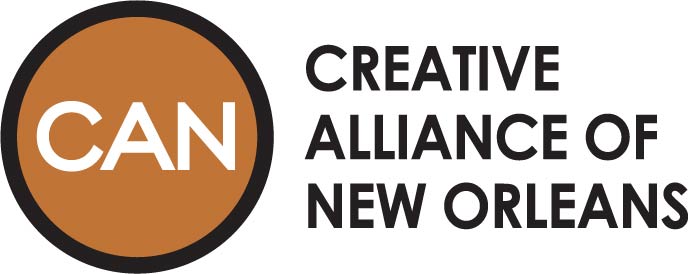Creative Industries White Paper
INTRODUCTION:
BY: JEANNE NATHAN | EXECUTIVE DIRECTOR
THE CREATIVE ALLIANCE OF NEW ORLEANS
The Creative Industries are exploding around the globe as automation picks off one manufacturing, retail, even tech job after another. 60% of those jobs are predicted to disappear over the coming decades. Visual, performing, media, design, literary and culinary arts can use the tools of automation, but cannot be replaced by them. They are place based, infinitely innovative, and underscore all other economic and business sectors as innovation becomes more vital than ever.
New Orleans’ creativity has set us apart for over 300 years, despite a lack of capital and commitment from the business, financial and political sectors. French and Spanish settler colonization of indigenous land through the practice of enslaving Africans has brought an incredible diversity of cultures to this location, while sluggish economic development in the aftermath of the Civil War and emancipation protected cultural, architectural and environmental resources. In the early 20th century, black New Orleanians persisted through the depths of Jim Crow segregation through the soaring heights of jazz, a musical miracle which made the city a mystical mecca for music lovers from Japan to Johannesburg.
At the same time, the city suffered an immeasurable loss as the black creators of jazz emigrated to Chicago and New York City, where the rewards of their talents were much greater and their lives and careers were less suffocated by Jim Crow. Louis Armstrong would become our leading
ambassador and a human metaphor for jazz itself. But he would rarely return to New Orleans, and live most of his years and die in Queens, New York. During the first half of the 20th century in the Vieux Carre, creators like Tennessee Williams and William Faulkner found the Quarter the perfect context for them to develop their musical, visual and literary arts, but theytoo would move on, seeking greater support in other American and European cities. This cultural trail continues today as we follow the careers of Wynton Marsalis, Harry Connick, Jr. and others… to New York, Los Angeles, Nashville and Miami.
In the second half of the century many supporters of the arts and architecture of New Orleans came to the defense of our culture, creating historic districts and staging conferences to highlight creative economy opportunities, and create new cultural institutions that now present the performing, visual and design arts of the city.
Our culture bearers have called attention to the importance of second line bands, Mardi Gras Indians, and we witness the growing appreciation of our traditional and newer musical forms from rhythm and blues, to rock and roll, funk, bounce and sissy bounce. Our Carnival season, while draining funding that might otherwise go to cultural venues and creators, has become recognized as a symbol of our unique culture, attracting thousands of visitors, employing New Orleanians in float and costume creation, and to performing for endless balls, neighborhood and private parties. The film, video, game and internet content industries are exploding, with the help of state tax benefits our citizens fought to secure.
The Afro-Caribbean shotgun has become as acclaimed as our Greek Revival mansions. Over 70 neighborhoods of the city have been recognized as historically important, and numerous cultural districts have been designated to preserve our history into the 21st century. Hurricane Katrina and the emerging recognition of the existential threats of
climate change and coastal erosion, while challenging our long term future, have also fueled the creative thinking of our citizens and the thousands of young creatives who came to help our city revive and stayed…so far. Now we are at a critical crossroads as cities worldwide have come to
recognize the importance of the creative industries and are developing robust economic development policies to retain, support and attract creatives, now recognized as the human building blocks to livable, sustainable cities. Over 60 cities in the United States have dynamic initiatives aimed at enhancing their attractiveness to creatives.
New Orleans failed to support its creatives at the dawn of the 20th century. Now we must fight to keep up with an international arc of economic change that will appeal to migrating creatives worldwide. And they are migrating…many coming here, but also to any city with a burgeoning cultural scene. It just takes a few dozen artists, a coffee shop or two, some galleries and small theaters where creatives can present their work, and… customers. We have that cultural scene…in neighborhoods throughout the city. In Treme, Bywater, Marigny, Central City, the 9th Ward, Arabi, on and around Magazine, Freret, St. Claude Street and O.C. Haley. The gentrification of these neighborhoods has also presented a new challenge, the poor and working-class culture bearers who live in them are displaced by wealthier professionals and short-term rental units.
A number of cultural leaders came together during the recent municipal elections, drafted a statement of how the city might better support the creative economy, secured endorsements from over 160 individuals and organizations, and successfully sought commitments from six councilmembers and from Mayor LaToya Cantrell who implemented a transition subcommittee on the creative industries. A vibrant dialogue on that committee has generated creative industries recommendations that the new administration and council will hopefully work to enact. New Orleans leaders and citizens have in the 2000s and 2010s have demonstrated recognition for the entrepreneurial spirit of the city, the growing importance of environmental issues and opportunities, and the long-standing love for our culture. Now is a critical moment for recognizing the role the creative industries can have in helping our city to achieve the promise of our competitive advantage and the true heart and soul of our lives, neighborhoods and future for our citizens.
Following is a further exploration of the importance of the creative industries, of how New Orleans is and can develop them, a sampling of the strategies ofhow peer cities are working to develop their creative economies.
LINK TO FULL WHITE PAPER: CREATIVE INDUSTRIES NEW ORLEANS WHITE PAPER
Related Posts
« Crevasse 22 in The New Orleans Advocate Landscapes, Monsters, and Pies on WWL TV, New Orleans »


